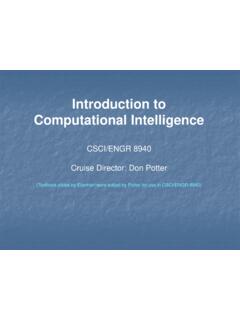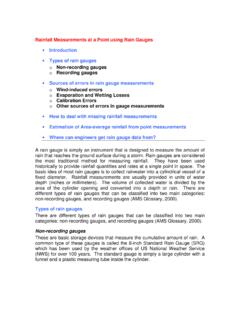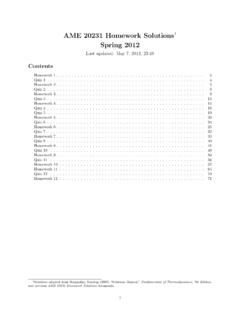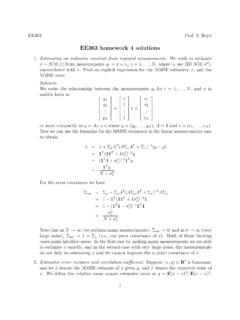Transcription of SOLUTIONS: Homework Assignment 2 - University of Georgia
1 solutions : Homework Assignment 2 CSCI 2670 Introduction to Theory of Computing, Fall 2018 September 18, 2018 This Homework Assignment is about NFA, NFA to DFA conversion, opera-tions on regular languages, and regular expressions1. Design an NFA to recognize the following language, where ={a,b,c}L1={w: the second last symbol ofwis not a }Answer:Figure 1: NFA forL1(credited: Connor Dooley)12. Design an NFA to recognize the following language, where ={a,b,c}L2={w:wcontains an even number ofa s or contains the pattern aa }Answer:Figure 2: NFA forL2(credited: Connor Dooley)3. Based on the work for Questions 1 and 2, design an NFA to recognize each of thefollowing languages:(a)L1 L2;(b)L1L2;(c)L 1;Answer:(a)Figure 3: NFA forL1 L2(credited: Connor Dooley)(b)Figure 4: NFA forL1L2(credited: Connor Dooley)(c)Figure 5: NFA forL 1(credited: Connor Dooley)4. Consider the following NFA. Convert it to an equivalent DFA using the studiedmethod. Note the simple conversion process is to construct the extension setEafterrelated transitions are determined.
2 For example, ifRis a subset of states in the NFAthat has transition function , then for symbolx, the new transition function (R,x)is computed as the result of the following sequence of steps:Figure 6: state diagram of an NFA(1) compute (r,x) for everyr R;(2) compute extension setE( (r,x)) for everyr R, if relevant -transitions exist;(3) take the union r RE( (r,x));Draw the final DFA converted from the :You would like to show all steps in computing the new transition function (R,x) foreveryRand everyx. Showing these steps serve two purposes:(a) to reward you with partial credits even if your final answer may be wrong, and(b) to remind you how you have come to the final answer.(1) There are 8 possible states in the new DFA: ,{q0},{q1},{q2},{q0,q1},{q0,q2},{q1,q2}, {q0,q1,q2}(2) The new transition is defined as: ({q0},a) ={q0,q1}, ({q0},b) = ({q0,q1},a) ={q0,q1}, ({q0,q1},b) ={q0,q1,q2} ({q0,q1,q2},a) ={q0,q1}, ({q0,q1,q2},b) ={q0,q1,q2}(3) The start state is{q0,q1};(4) The accept states are{q0,q1}and{q0,q1,q2}.
3 Figure 7: Converted DFA5. For each of the following regular expressions, give two positive and two negativemembers for the language it generates:(a)a(ba) b;(b) ( b)a;Answers:(a)positive members:ab,ababababnegative members:aba, (b)positive members:a,banegative members:ab,bb6. Design an NFA for each of language given in Question (a)Figure 8: NFA fora(ba) b(credited: Connor Dooley)(b)Figure 9: NFA for ( b)a(credited: Connor Dooley)7. Give regular expressions for the following languages, where ={0,1}(a){w:wcontains exactly two 0 s}(b){w:wcontains at least two 0 s and at most one 1}Hints: There are only a few ways that exactly two 0 s can be arrangedin a string. At least two 0 s is the same as exactly two 0 s or more thantwo 0 s .answers:(a) 1 01 01 (b) 000 1000 0100 000 10 8. In certain programming languages, comments appear between delimiters such as/#and #/. LetCbe the language of all valid delimited comment strings. Such a stringinCmust begin with/# and end with #/but have no intervening #/.
4 For simplicity,assume the alphabet ={a,b,/,#}.(a) Give an NFA that recognizes languageC.(b) Give a regular expression that :(a)Figure 10: NFA that recognizes languageC(b)/#(a b / (# (a b))) #/NOTE: All Homework answers need to be word-processed or typed. Hand-writing onlyapplies to figure or table drawings. A hard copy of answers should be received in classroomor in the instructor s office by 5:00pm on the due date. Policy on late Homework answersis given in the submission will not be accepted unless a such a request hasbeen approved.










